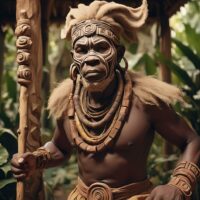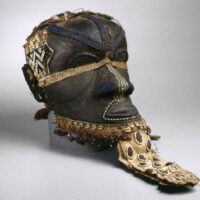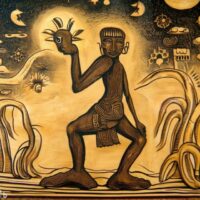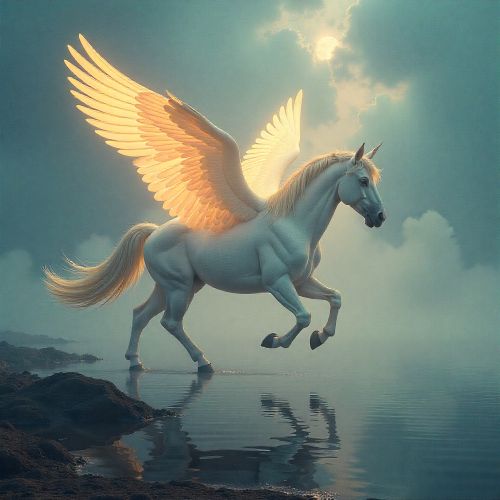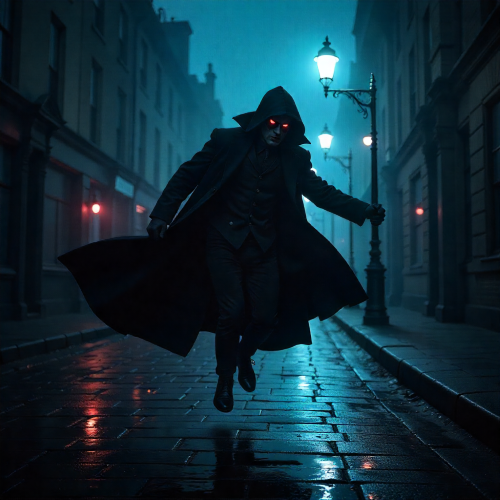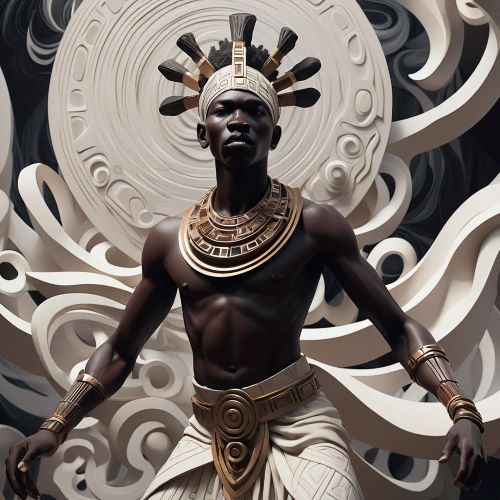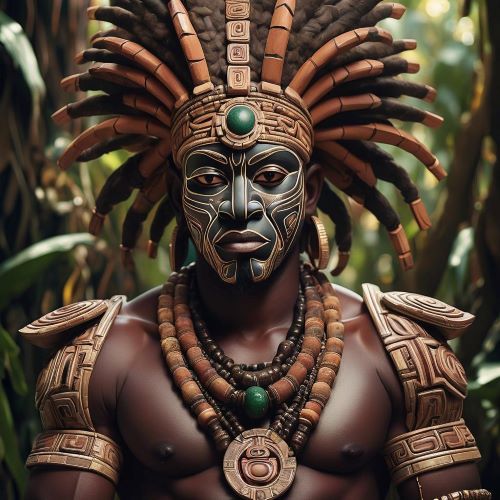Woot : The Founding Father
Listen
At a glance
| Description | |
|---|---|
| Origin | Kuba Mythology |
| Classification | Gods |
| Family Members | N/A |
| Region | Democratic Republic of Congo |
| Associated With | Founding the tribe |
Woot
Introduction
In Kuba mythology, Woot stands as a revered and complex figure, credited with shaping the world, establishing societal structures, and introducing language. Their legacy is deeply woven into the cultural fabric of the Kuba people of the Democratic Republic of Congo. The Kuba Kingdom, thriving between the 17th and 19th centuries, encompassed various Bushong-speaking principalities, including the Kete, Coofa, Mbeengi, and the Kasai Twa Pygmies. At the core of Kuba mythology, Woot emerges as a supernatural being pivotal in shaping their culture and civilization, embodying wisdom, strength, and a significant role in the cosmos.
Physical Traits
Woot is depicted as a towering figure in the mythical forests of Kuba, surpassing even the tallest trees. Their form blends human-like features with elements of the natural world—adorned with leaves and roots, symbolizing a deep connection to the earth’s life force. Emerald eyes reflect eons of wisdom, while a voice resonates like the rustling wind, conveying tranquility and authority. Unlike many deities, Woot’s physical characteristics are less emphasized in Kuba art, which instead focuses on embodying his spirit in masks and ceremonial figures. Variations of the myth portray Woot as a skilled hunter, suggesting agility and strength. He is revered by the Kuba as the first human, the bestower of knowledge, and the catalyst for their societal advancement.
Family
In Kuba mythology, Woot’s lineage is recounted through two prominent narratives that illuminate his central role in their cosmology. According to one account, Woot is celebrated as one of nine children born to Mboom, the sky god. Each sibling in this divine family contributed uniquely to the creation of the world, with Woot specifically recognized for naming animals and establishing order among them. This version of his origin places Woot among a pantheon of powerful beings, underscoring his pivotal role in shaping the cosmic balance and order.
Another narrative portrays Woot as the foundational ancestor of the Kuba people. In this tale, he emerges directly from the earth, symbolizing his deep connection to the land and its life-giving forces. Revered as the first human, Woot is honored as the progenitor of the Kuba lineage, earning them the esteemed title of the “Children of Woot.” According to tradition, he was adopted by a Kuba queen, thus intertwining his lineage with the ruling dynasty and solidifying his place as the ancestor of their noble bloodline.
Within the intricate tapestry of Kuba mythology, Woot’s familial role extends beyond his divine lineage. He is often depicted as a sibling to celestial bodies—the sun and moon—underscoring his connection to the natural world and its cycles. Revered as a child of the earth goddess, Woot embodies the harmonious balance between day and night, light and darkness. His presence bridges the realms of mortals and the supernatural, embodying both the nurturing warmth of the sun and the contemplative mystery of the moon. This familial bond not only shapes the Kuba worldview but also symbolizes the enduring cycles of time and the cosmic forces that govern their existence.
Other names
In diverse regions and eras of Kuba mythology, Woot is recognized under various names that reveal their multifaceted nature and diverse roles in rituals and stories. Different traditions refer to them as Wut or Wout, highlighting specific aspects of their character and significance within distinct cultural contexts. These variations underscore Woot’s adaptable presence in the collective imagination of the Kuba people, evolving across different narratives and interpretations over time. Variants like Woto in pronunciation further demonstrate the richness of oral traditions within Kuba mythology, enhancing the depth of Woot’s portrayal.
Across different Kuba subgroups, Woot assumes different identities. Some communities know him as “Mwaash aMbooy,” emphasizing his foundational role in Kuba history and cultural identity. The title “Children of Woot” resonates deeply among the Kuba, affirming their shared lineage with this legendary figure and reinforcing a collective sense of heritage and belonging. These varied names and titles encapsulate the diverse facets of Woot’s mythological persona, illustrating their enduring significance and cultural resonance among the Kuba people throughout history.
Powers and Abilities
Woot’s legendary abilities encompass a wide spectrum that profoundly influenced both the world and Kuba society. Central to their mythos is the role of creation, where Woot brought order by naming animals, plants, and potentially even language itself. They are credited with establishing the matrilineal system within Kuba society, a social structure where inheritance and leadership are passed through the female line—a decision rooted in a tale where Woot rewards his modest daughter and punishes mocking sons. As a skilled hunter, Woot exemplifies mastery over the natural world, providing sustenance and knowledge to their people. Their leadership qualities further solidify their role as a founder and guide, shaping the early development of the Kuba people.
Woot’s divine status is underscored by their shape-shifting abilities, enabling transformations into majestic animals or ethereal spirits that embody the essence of nature in Kuba mythology. Their wisdom extends to herbal lore, healing arts, and the intricate rituals that maintain harmony between mortal existence and the divine realm. In tales of creation, Woot is revered for fashioning the first humans from clay and animating them with a gentle whisper that resonates through generations. They wield control over natural forces, from summoning cleansing storms to nurturing crops, ensuring prosperity for those who worship them. These powers establish Woot as a protective and nurturing deity, revered among the Kuba for their benevolent guidance and formidable presence.
However, Woot’s mythology also includes complex and morally challenging narratives. The tale of their incestuous relationship with their sister, Mweel, resulting in exile, raises profound questions about morality and the boundaries between divine and mortal realms. Interpretations vary, with some viewing this episode as a symbolic separation of these realms, while others see it as a cautionary tale highlighting the risks of unchecked power and relationships.
Modern Day Influence
Woot’s influence extends beyond mere stories; it finds embodiment in the Bwoom mask, a central figure in Kuba masquerade performances. Often paired with a mask representing the king, these performances highlight the tension between established authority and the potential for disruption, allowing participants to engage with Woot’s spirit, reenact his deeds, and grapple with the complexities of his legacy. Today, Woot maintains a significant presence in Kuba culture; his name permeates greetings and proverbs, underscoring his enduring role as a foundational figure. The matrilineal system he established remains integral to Kuba society, while the tradition of Kuba masks, including the iconic Bwoom mask representing Woot, continues to thrive as a vital form of cultural expression and historical preservation.
Though the historical Kuba Kingdom no longer exists in its original form, Woot’s legacy perseveres. His symbolism persists in Kuba art, rituals, and cultural practices, with contemporary communities honoring their mythical progenitor through masquerades, dances, and oral traditions. Woot serves as a bridge connecting past traditions with present-day realities, reminding the Kuba people of their rich cultural heritage and collective identity. His legacy, however, is nuanced; celebrated as a hero who brought order, taught language, and established societal structures, Woot is also portrayed as a flawed figure capable of both creation and destruction.
While rooted in ancient traditions, Woot’s enduring influence manifests in modern Kuba culture through festivals, ceremonies, and artistic interpretations that celebrate his mythical exploits and lasting impact. Artisans craft intricate tapestries depicting Woot’s adventures, while storytellers recount tales of his wisdom and compassion to captivated audiences. Across urban centers and rural villages, statues and shrines dedicated to Woot honor him as a guardian of tradition and a symbol of resilience in the face of adversity. Beyond cultural preservation, Woot’s archetype resonates with contemporary themes of environmental stewardship and spiritual interconnectedness, inspiring movements that seek harmony between human activities and the natural world. His legacy thus serves as a timeless testament to the transformative power of myth, shaping beliefs, fostering community, and evoking wonder in those who ponder life’s mysteries.
Related Images
Frequently Asked Questions
What is lorem Ipsum?
I am text block. Click edit button to change this text. Lorem ipsum dolor sit amet, consectetur adipiscing elit. Ut elit tellus, luctus nec ullamcorper mattis, pulvinar dapibus leo.
What is lorem Ipsum?
I am text block. Click edit button to change this text. Lorem ipsum dolor sit amet, consectetur adipiscing elit. Ut elit tellus, luctus nec ullamcorper mattis, pulvinar dapibus leo.
What is lorem Ipsum?
I am text block. Click edit button to change this text. Lorem ipsum dolor sit amet, consectetur adipiscing elit. Ut elit tellus, luctus nec ullamcorper mattis, pulvinar dapibus leo.
What is lorem Ipsum?
I am text block. Click edit button to change this text. Lorem ipsum dolor sit amet, consectetur adipiscing elit. Ut elit tellus, luctus nec ullamcorper mattis, pulvinar dapibus leo.
What is lorem Ipsum?
I am text block. Click edit button to change this text. Lorem ipsum dolor sit amet, consectetur adipiscing elit. Ut elit tellus, luctus nec ullamcorper mattis, pulvinar dapibus leo.


